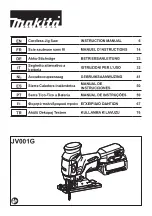
25
E N G L I S H
WARNING:
Never attempt to open the battery
pack for any reason. If battery pack case
is cracked or damaged, do not insert into
charger. Do not crush, drop or damage battery
pack. Do not use a battery pack or charger
that has received a sharp blow, been dropped,
run over or damaged in any way (i.e., pierced
with a nail, hit with a hammer, stepped on).
Damaged battery packs should be returned to
service center for recycling.
CAUTION: When not in use, place tool
on its side on a stable surface where it
will not cause a tripping or falling hazard.
Some tools with large battery packs will stand
upright on the battery pack but may be easily
knocked over.
SPECIFIC SAFETY INSTRUCTIONS FOR NICKEL
CADMIUM (NiCd) OR NICKEL METAL HYDRIDE
(NiMH)
•
Do not incinerate the battery pack even if it is
severely damaged or is completely worn out.
The battery pack can explode in a fi re.
•
A small leakage of liquid from the battery
pack cells may occur under extreme usage or
temperature conditions.
This does not indicate
a failure. However, if the outer seal is broken:
a. and the battery liquid gets on your skin,
immediately wash with soap and water for
several minutes.
b. and the battery liquid gets into your eyes,
fl ush them with clean water for a minimum
of 10 minutes and seek immediate medical
attention. (
Medical note:
The liquid is 25-35%
solution of potassium hydroxide.)
SPECIFIC SAFETY INSTRUCTIONS FOR LITHIUM
ION (LI ION)
•
Do not incinerate the battery pack even if it is
severely damaged or is completely worn out.
The battery pack can explode in a fi re. Toxic fumes
and materials are created when lithium ion battery
packs are burned.
•
If battery contents come into contact with the
skin, immediately wash area with mild soap
and water.
If battery liquid gets into the eye, rinse
water over the open eye for 15 minutes or until
irritation ceases. If medical attention is needed,
the battery electrolyte is composed of a mixture of
liquid organic carbonates and lithium salts.
•
Contents of opened battery cells may cause
respiratory irritation.
Provide fresh air. If
symptoms persists, seek medical attention.
WARNING:
Burn hazard. Battery liquid may
be fl ammable if exposed to spark or fl ame.
Battery Cap (fi g. B)
A protective battery cap is supplied to cover the
contacts of a detached battery pack. Without the
protective cap in place, loose metal objects could short
circuit the contacts, causing a fi re hazard and damaging
the battery pack.
1. Take off the protective battery cap (18) before
placing the battery pack in the charger or tool.
2. Place the protective cap over the contacts
immediately after removing the battery pack from
the charger or tool.
WARNING:
Make sure the protective battery
cap is in place before storing or carrying
a detached battery pack.
Battery Pack (fi g. A)
BATTERY TYPE
The A-KS 18V operate on 18 volt battery packs.
Storage Recommendations
1. The best storage place is one that is cool and dry
away from direct sunlight and excess heat or cold.
2. Long storage will not harm the battery pack or
charger. Under proper conditions, they can be
stored for 5 years or more.
Labels on Charger and Battery Pack
In addition to the pictographs used in this manual, the
labels on the charger and the battery pack show the
following pictographs:
Read instruction manual before use.
Battery charging.
Battery charged.
Battery defective.
Hot/cold pack delay.
Do not probe with conductive objects.
Do not charge damaged battery packs.
















































